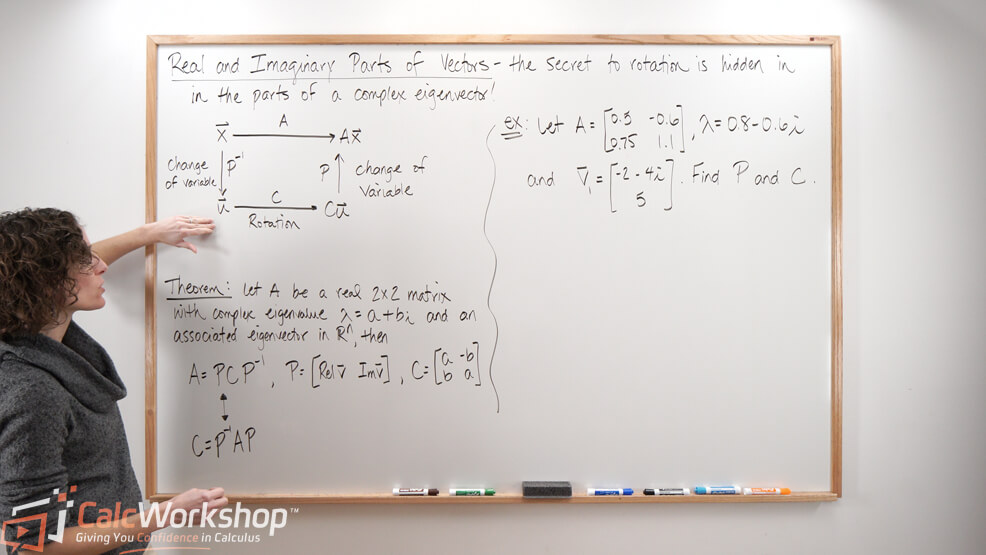Remember how we were told in Algebra that the polynomial degree indicates the number of roots it has? Meaning there is the possibility of getting distinct real roots, repeated real roots, or even complex roots.

Jenn, Founder Calcworkshop®, 15+ Years Experience (Licensed & Certified Teacher)
Well, guess what? This is true with matrices as well!
Why?
Complex Eigenvalues and Eigenvectors
Because the characteristic equation of a square n x n matrix is a polynomial equation of degree n, with exactly n roots, counting multiplicities and the possibility of complex roots. Therefore, a real matrix A may also have complex roots, yielding complex eigenvalues and eigenvectors.
The great thing is that we already know how to do this. We just need to brush up on our imaginary and complex number system.
Alright, so a complex number is the sum of a real number and an imaginary number:
\begin{align*}
&\underbrace{a}_{\text {real }} \pm \underbrace{b i}_{\text {imaginary }}
\end{align*}
And, if you recall, all complex numbers come in pairs called conjugate pairs. Therefore, if matrix A is an n x n matrix whose entries are real numbers, and if λ is an eigenvalue of A and \(\vec{x}\) is a corresponding eigenvector in the complex system Cn, then its complex eigenvalues occur in conjugate pairs.
Cool, right?
- Okay, so let’s see how this works.
Find the eigenvalues and basis for the eigenspace in \(\mathbb{C}^{2}\) for \(A=\left[\begin{array}{cc}1 & -2 \\ 1 & 3\end{array}\right]\).
Finding Complex Eigenvalues and Eigenvectors
First, we will find our eigenvalues.
\begin{aligned}
& \operatorname{det}\left[\begin{array}{cc}
1-\lambda & -2 \\
1 & 3-\lambda
\end{array}\right] = 0 \\
& (1-\lambda)(3-\lambda)-(-2)(1) = 0 \\
& \lambda^{2}-4 \lambda+5 = 0
\end{aligned}
\begin{aligned}
& \lambda = \frac{-(-4) \pm \sqrt{(-4)^{2}-4 \cdot 1 \cdot 5}}{2(1)} \\
& = \frac{4 \pm \sqrt{-4}}{2} \\
& = \frac{4 \pm 2 i}{2} \\
& = 2 \pm i
\end{aligned}
Now, we will find our two corresponding eigenvectors.
\begin{aligned}
& \lambda=2+i \Rightarrow\left[\begin{array}{ccc}
1-(2+i) & -2 & 0 \\
1 & 3-(2+i) & 0
\end{array}\right] \\
& =\left[\begin{array}{ccc}
-1-i & -2 & 0 \\
1 & 1-i & 0
\end{array}\right] \\
& \sim\left[\begin{array}{ccc}
1 & 1-i & 0 \\
0 & 0 & 0
\end{array}\right] \\
& \Rightarrow \vec{x}=\left[\begin{array}{c}
-1+i \\
1
\end{array}\right]
\end{aligned}
\begin{aligned}
& \lambda=2-i \Rightarrow\left[\begin{array}{ccc}
1-(2-i) & -2 & 0 \\
1 & 3-(2-i) & 0
\end{array}\right] \\
& =\left[\begin{array}{ccc}
-1+i & -2 & 0 \\
1 & 1+i & 0
\end{array}\right] \\
& \sim\left[\begin{array}{ccc}
1 & 1+i & 0 \\
0 & 0 & 0
\end{array}\right] \\
& \Rightarrow \vec{x}=\left[\begin{array}{c}
-1-i \\
1
\end{array}\right]
\end{aligned}
Which means our basis is:
\begin{equation}
\left\{\left[\begin{array}{c}
-1+i \\
1
\end{array}\right],\left[\begin{array}{c}
-1-i \\
1
\end{array}\right]\right\}
\end{equation}
See, finding complex eigenvectors isn’t hard at all. And don’t worry. We’ll work through the steps for row reduction using complex numbers in the video to help you make sense of things.
Real Matrices with Complex Eigenvalues: Rotation and Scaling
Now, it’s time to let you in on a little secret — there’s a hidden rotation within a real matrix having a complex eigenvalue.
If \(\mathrm{A}\) is as real \(2 \times 2\) matrix with a complex eigenvalue \(\lambda=\underset{\operatorname{Re}}{a}-\underset{\mathrm{Im}}{b} i\), where \(b \neq 0\) and an associated eigenvector \(\vec{v}\) in \(\mathbb{C}^{2}\), then:
\begin{align*}
A=P C P^{-1} \quad \text { where } P=\left[\begin{array}{ll}
\operatorname{Re} \vec{v} & \operatorname{Im} \vec{v}
\end{array}\right] \text { and } C=\left[\begin{array}{cc}
a & -b \\
b & a
\end{array}\right]
\end{align*}
Let’s look at two examples to help us make sense of this new “hidden” idea.
Example: Finding Angle of Rotation and Scale Factor
In this next example, we will find the angle of rotation given matrix A using a handy-dandy formula.
Suppose \(A=\left[\begin{array}{cc}\sqrt{3} & -1 \\ 1 & \sqrt{3}\end{array}\right]\) with eigenvalues \(\lambda=\sqrt{3} \pm i\).
Give the angle \(\varphi\) of the rotation, where \(-\pi<\varphi<\pi\), and give the scale factor \(\mathrm{r}\).
First, \(\varphi\) is the angle between the positive \(x\)-axis and the ray from the origin through the point \((a, b)\).

Graphing Complex Eigenvector (Real – Imaginary Plane)
Therefore, the transformation \(\vec{x} \mapsto C \vec{x}\) is the composition of a rotation through the angle \(\varphi\) and then a scaling by \(r=\|\lambda\|=\sqrt{a^{2}+b^{2}}\).

Angle Rotation (Complex Eigenvector)
This means that the scale factor \(r\) is \(r=\sqrt{(\sqrt{3})^{2}+(1)^{2}}=\sqrt{4}=2\)
And using the following formula, we can find the angle of rotation.
\begin{aligned}
C &= \left[\begin{array}{cc}
r & 0 \\
0 & r
\end{array}\right]\left[\begin{array}{cc}
\cos \varphi & -\sin \varphi \\
\sin \varphi & \cos \varphi
\end{array}\right] \\
\left[\begin{array}{cc}
\sqrt{3} & -1 \\
1 & \sqrt{3}
\end{array}\right] &= \left[\begin{array}{ll}
2 & 0 \\
0 & 2
\end{array}\right]\left[\begin{array}{cc}
\cos \varphi & -\sin \varphi \\
\sin \varphi & \cos \varphi
\end{array}\right] \\
\left[\begin{array}{cc}
\sqrt{3} & -1 \\
1 & \sqrt{3}
\end{array}\right] &= \left[\begin{array}{ll}
2 \cos \varphi & -2 \sin \varphi \\
2 \sin \varphi & 2 \cos \varphi
\end{array}\right]
\end{aligned}
So, by setting one of the corresponding elements equal to each other (it doesn’t matter which one because they will all equal the same value), we can solve for \(\varphi\)
\begin{aligned}
\left[\begin{array}{cc}
\sqrt{3} & -1 \\
1 & \sqrt{3}
\end{array}\right] &= \left[\begin{array}{cc}
2 \cos \varphi & -2 \sin \varphi \\
2 \sin \varphi & 2 \cos \varphi
\end{array}\right] \\
\sqrt{3} &= 2 \cos \varphi \\
\cos \varphi &= \frac{\sqrt{3}}{2}
\end{aligned}
\(\varphi=\frac{\pi}{6}\)
Example: Finding Invertible Matrix P and Matrix C
Okay, so now let’s investigate how to find an invertible matrix \(\mathrm{P}\) and \(\mathrm{C}\) such that \(A=P C P^{-1}\).
For example, if we use our first example where we have
\begin{aligned}
& A=\left[\begin{array}{cc}1 & -2 \\ 1 & 3\end{array}\right]
\end{aligned}
with eigenvalues
\begin{aligned}
& \lambda=2 \pm i
\end{aligned}
and corresponding eigenvectors
\begin{aligned}
& \left\{\left[\begin{array}{c}-1+i \\ 1\end{array}\right],\left[\begin{array}{c}-1-i \\ 1\end{array}\right]\right\}
\end{aligned}
let’s find an invertible matrix \(\mathrm{P}\) and a matrix \(\mathrm{C}\) of the form
\begin{aligned}
& C=\left[\begin{array}{cc}a & -b \\ b & a\end{array}\right]
\end{aligned}
First, let’s find our P matrix, knowing that \(\mathrm{P}\) represents the columns of our eigenvectors where we separate the real component from the imaginary part.
But here’s the trick… we just need to choose one of the eigenvectors because they are conjugate pairs.
So, if we select
\begin{aligned}
& \left[\begin{array}{c}-1+i \\ 1\end{array}\right]
\end{aligned}
as our eigenvector, we can write our P matrix as follows
If
\begin{aligned}
& \left[\begin{array}{c}-1+i \\ 1\end{array}\right]=\left[\begin{array}{c}-1+1 i \\ 1+0 i\end{array}\right]
\end{aligned}
then
\begin{aligned}
& P=\left[\begin{array}{cc}\operatorname{Re} \vec{v} & \operatorname{Im} \vec{v}\end{array}\right] \\
& \Rightarrow P=\left[\begin{array}{cc}-1 & 1 \\ 1 & 0\end{array}\right]
\end{aligned}
Now, our C matrix is of the form
\begin{aligned}
& C=\left[\begin{array}{cc}a & -b \\ b & a\end{array}\right]
\end{aligned}
where a and \(b\) are from our eigenvalue. Again, the trick is to choose the eigenvalue that corresponds to the chosen eigenvector.
Since
\begin{aligned}
& \lambda=2+i \Rightarrow\left[\begin{array}{c}-1+i \\ 1\end{array}\right] \\
& \underbrace{2}_{a}+\underbrace{1}_{b} i
\end{aligned}
So,
\begin{aligned}
& C=\left[\begin{array}{cc}2 & -1 \\ 1 & 2\end{array}\right]
\end{aligned}
And that it!
In this lesson, you will:
- Find complex eigenvalues and complex eigenvectors
- Discover that the secret to rotation and trajectory, according to Paul’s Online Notes, is hidden in the real and imaginary parts of a complex eigenvector
Get ready to uncover the hidden secrets and dive in!
Video Tutorial w/ Full Lesson & Detailed Examples

Get access to all the courses and over 450 HD videos with your subscription
Monthly and Yearly Plans Available
Still wondering if CalcWorkshop is right for you?
Take a Tour and find out how a membership can take the struggle out of learning math.